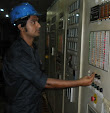PLC Programming
The first PLCs were programmed with a
technique that was based on relay logic wiring schematics. This eliminated the
need to teach the electricians, technicians and engineers how to program a
computer - but, this method has stuck and it is the most common technique for
programming PLCs today.
An example of ladder logic can be seen
in Figure Below. To interpret this diagram imagine that the power is on the
vertical line on the left hand side, we call this the hot rail. On the right
hand side is the neutral rail. In the figure there are two rungs, and on each
rung there are combinations of inputs (two vertical lines) and outputs
(circles). If the inputs are opened or closed in the right combination the
power can flow from the hot rail, through the inputs, to power the outputs, and
finally to the neutral rail. An input can come from a sensor, switch, or any
other type of sensor. An output will be some device outside the PLC that is
switched on or off, such as lights or motors. In the top rung the contacts are
normally open and normally closed. Which means if input A is on and
input B is off, then power will flow through the output and activate it.
Any other combination of input values will result in the output X being
off.
 |
| A simple ladder logic diagram |
Note:
Power needs to flow through some combination of the inputs (A,B,C,D,E,F,G,H) to
turn on outputs (X,Y).
The second rung of Figure above is
more complex, there are actually multiple combinations of inputs that will
result in the output Y turning on. On the left most part of the rung,
power could flow through the top if C is off and D is on. Power
could also (and simultaneously) flow through the bottom if both E and F
are true. This would get power half way across the rung, and then if G or
H is true the power will be delivered to output Y. In later chapters
we will examine how to interpret and construct these diagrams.









No comments